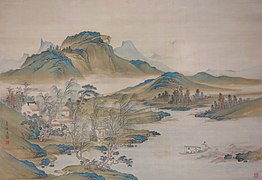Watanabe Gentai
Watanabe Gentai ( Japanese 渡 辺 玄 對 , also read Watanabe Gensui, actual name Uchida Ei ( 内 田 瑛 ), other artist names: Shōdai ( 松 台 ), Rinroku Sōdō ( 林 麓 草堂 ), Shōdō ( 松 堂 ), Suigu ( 酔 愚 ); Born 1749 in Edo ; died June 1, 1822 ) was a Japanese painter of the late Edo period .
life and work
Watanabe was originally called Uchida, he was then adopted by the painter Watanabe Sōsui. He learned the basics of painting from his adoptive father and after his death studied under Nakayama Kōyō ( 中山 高 陽 ; 1717–1780). He was very impressed by the paintings of famous Chinese painters, especially those from the Ming period , such as Lan Ying (c. 1585–1664) and Shen Quan . So he made landscapes and flower and bird pictures ( 花鳥画 , kachōzu ), in which he imitated the style of his role models.
Watanabe Gentai is known as the teacher of Tani Bunchō and was thus one of the artists who founded the Nanga style in the Kantō area. He died at the age of 73 and was buried in the Kōrin-ji Temple in the Azabu area of Edo. One of his best-known pictures is “The Peach Blossom City Wuling ” ( 武陵 桃源 図 ) in the Tokyo National Museum . His instruction on painting, entitled Gentai gafu ( 玄 対 画譜 ), was widely used.
photos
literature
- Tazawa, Yutaka: Watanabe Gentai . In: Biographical Dictionary of Japanese Art . Kodansha International, 1981. ISBN 0-87011-488-3 .
- Laurance P. Roberts: Gentai . In: A Dictionary of Japanese Artists . Weatherhill, 1976. ISBN 0-8348-0113-2 .
Web links
| personal data | |
|---|---|
| SURNAME | Watanabe, Gentai |
| ALTERNATIVE NAMES | 渡 辺 玄 對 (Japanese); Uchida Egg (real name); 内 田 瑛 (real name, Japanese) |
| BRIEF DESCRIPTION | Japanese painter |
| DATE OF BIRTH | 1749 |
| PLACE OF BIRTH | Edo |
| DATE OF DEATH | June 1, 1822 |

